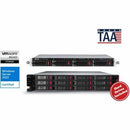Description
The BUFFALO TeraStation 5420 is a business-ready, high-performance 4-bay NAS designed to simplify data management for growing teams. Baked in with four 8TB drives, this turnkey rackmount storage solution delivers a ready-to-use 32TB capacity, enabling immediate file sharing, centralized backups, and secure collaboration across Windows, macOS, and Linux environments. Built for reliability, scalability, and ease of administration, the TeraStation 5420 fits neatly into standard 19-inch racks and balances robust performance with energy-efficient operation. If your organization needs dependable storage for shared folders, backups, media libraries, and project archives, the 5420 provides a solid foundation with enterprise-grade features at a small-business price point.
- Ready-to-use 32TB storage — This configuration arrives with 4 x 8TB drives installed, delivering a comprehensive, plug-and-play storage pool for immediate file sharing, centralized backups, and long-term data retention without the need to source and install drives separately.
- Flexible RAID protection for data safety — The TeraStation 5420 supports multiple RAID configurations to balance data protection and performance. Whether you need RAID for fault tolerance (such as RAID 5 or RAID 6) or maximum performance (RAID 0 or RAID 10), you can tailor storage to your workflow while retaining smooth access to critical business files.
- Cross‑platform file sharing and backups — Designed for mixed environments, it offers access through common network protocols suitable for Windows, macOS, and Linux clients. Centralized shares, user access controls, and straightforward backup workflows streamline collaboration and data protection across the entire organization.
- Business-ready reliability and management — The 1U rackmount chassis is built for 24/7 operation in business environments. Hot-swappable drive bays minimize downtime during maintenance, and the integrated administrative interface provides proactive monitoring, alerting, and remote management to keep IT ops efficient.
- Seamless integration with backups and expansion — Beyond primary storage, the TeraStation 5420 supports scalable backup options and easy integration with peripheral devices and additional storage for growth. Its design focuses on simplifying data protection, archiving, and scalable storage for teams that depend on quick, reliable access to files and backups.
Technical Details of Buffalo TeraStation 5420
- Model: Buffalo TeraStation 5420
- Drive Bays: 4 bays with four 8TB drives included (total 32TB)
- Drive Type: SATA hard drives; hot-swappable bays for easy maintenance
- Total Capacity: 32 TB (pre-configured with 4 x 8TB drives)
- RAID Support: Configurable RAID levels (RAID 0/1/5/6/10) for flexibility between performance and protection
- Networking: 1 x Gigabit Ethernet port for local network access
- Expansion and Connectivity: USB ports for external backup and expansion
- Operating System: Buffalo TeraStation NAS OS with web-based management
- Form Factor: 1U rackmount chassis suitable for standard 19-inch racks
- Security and Access: Built-in user accounts and access controls to manage file permissions
- Power and Environment: Desktop-class power supply suitable for office environments; designed for continuous operation
- Compatibility: Cross-platform support for Windows, macOS, and Linux clients via common network protocols
How to install Buffalo TeraStation 5420
Follow these steps to deploy and start using your Buffalo TeraStation 5420 quickly and confidently:
- Unbox and position the 5420 in a well-ventilated area within your rack. Ensure adequate clearance for airflow and access to network cables.
- Mount the unit in a standard 19-inch rack if rack mounting is required, using the supplied rails and hardware. Secure the chassis to minimize vibration and movement.
- Connect the included power supply to an appropriate AC outlet and plug in the Ethernet cable to your switch or router. Power on the device and wait for the system to initialize.
- Access the web-based management interface from a connected computer. Using your browser, enter the default IP address or use the auto-discovery utility provided by Buffalo to locate the device on your network.
- Configure the initial setup, including RAID level selection, shared folders, user accounts, and access permissions. If you’re upgrading from an existing storage solution, consider migrating data and reconfiguring shares to optimize performance and security.
- Review and apply firmware updates to ensure you have the latest stability and security improvements. Schedule regular firmware checks to stay current.
- Set up backups and replication as needed. Define backup targets (local USB/external storage or network destinations) and configure automated backup jobs to protect critical business data.
- Test access from multiple clients (Windows, macOS, Linux) to verify permissions and performance. Validate read/write speeds and ensure that users can access shared folders without issues.
- Document configuration details for IT records and establish a routine for monitoring disk health, storage utilization, and alert notifications via the admin UI.
Frequently asked questions
-
Q: Does the Buffalo TeraStation 5420 come with drives included?
A: Yes. This model ships with four 8TB drives pre-installed for a total capacity of 32TB, enabling immediate deployment and data storage without the need to source drives separately. -
Q: What RAID configurations are supported?
A: The 5420 supports multiple RAID levels (including RAID 0, 1, 5, 6, and 10), allowing you to optimize for performance, capacity, and redundancy based on your data protection strategy. -
Q: Which clients can access the NAS?
A: It provides cross-platform access for Windows, macOS, and Linux clients through common network protocols such as SMB, NFS, and FTP, simplifying collaboration across diverse environments. -
Q: Is this suitable for business backups?
A: Yes. The TeraStation 5420 is designed for centralized backups, file sharing, and archiving. It supports scheduled backups to local USB/external devices and network destinations, helping protect important business data. -
Q: How do I manage the device?
A: Management is done via a web-based interface that you can access from any connected computer. The UI provides setup wizards, monitoring dashboards, disk health alerts, user management, and share configuration to streamline IT administration.
Customer reviews
Showing - Of Reviews


